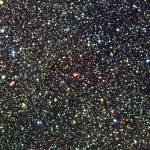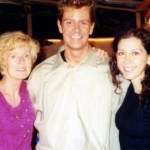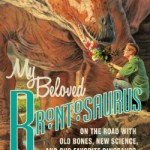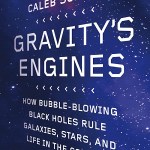Science
"All our sweetest hours fly the fastest." -Virgil
If you've been around the block once or twice, you know that the speed of light in a vacuum -- 299,792,458 meters-per-second -- is the absolute maximum speed that any form of energy in the Universe can travel at. In shorthand, this speed is known as c to physicists.
Image credit: user Fx-1988 of deviantART.
But you or I, no matter how hard we try, will never attain that speed. There's a simple reason for this: we have mass. And for an object with mass, you can accelerate it all you want, but it would take an infinite amount…
The playground outside SteedlyKid's day care, amazingly in this litigious age, has a merry-go-round, a rotating disc with a really good bearing. The kids can really get the thing flying, which is kind of terrifying at times. But on the bright side, it's an excellent venue for the physics of angular momentum:
In the embedded video, SteelyKid runs in and starts the merry-go-round spinning, then jumps aboard and goes around one full rotation before moving to the center for a few rotations, and then starting to move back out.
This isn't exactly what I was hoping for-- amazingly, a four-and-two-…
I've written a lot about a doctor named Stanislaw Burzynski who claims to have much better outcomes in treating deadly brainstem tumors than conventional oncology does. Although the way he claims to do it is through the use of substances he calls "antineoplastons," which he claimed to have isolate from the urine of patients. Over 35 years after having formed his own clinic and "research institute" to use these compounds to treat cancer and after having had over 60 phase I and phase II clinical trials registered with ClinicalTrials.gov, with none of these completed trials having been published…
A couple of days ago, Alom Shaha posted on the new Physics Focus blog (by the way, there's a new Physics Focus blog...) about his dissatisfaction with some popular books:
I recently read a popular science book on a topic that I felt I needed to learn more about. The book was well written, ideas were clearly explained, and I finished the book knowing a lot more about the history of the subject than beforehand. However, I don’t feel I understand the key ideas in the book any better. I won’t mention the name of the book or the author because this post isn’t really about that specific book. It’s…
A few weeks ago I gave a talk in Seattle in which I pointed out that science is not sufficient to define moral behavior. A substantial part of that talk was a catalog of atrocities, such as the Tuskegee syphilis experiment. I said that in purely scientific terms, that was a good experiment; if the subjects had been mice, for instance, setting aside an untreated control group to study the progression of the disease would have been considered an essential part of smart experimental design. One could still argue that the needs of the many outweigh the needs of the few…if one were willing to…
Nobody's ever going to mistake me for an elite basketball player. I'm taller than average (about 6'6", a hair under 2m in SI units), but I'm not especially quick, or agile, or all that good a jumper. And I'm carrying at least 40lbs of extra weight above what a really good player my size would (in terms of mass, I'm closer to the dimensions of a really good (American) football player, though not nearly enough of it is muscle).
This doesn't stop me from playing basketball, though. I love the game, and I play a good deal, at least for a guy in his forties with a full-time job. I can hold my own…
It's a frog tadpole with an eye surgically grafted to its trunk!
Wait, this is an old story — similar experiments were done at least 20 years ago. You can transplant developing eyes to the tadpole, but the cool thing is that the donor optic nerves will grow into the sensory tracts of the dorsal spinal cord and grow anteriorly to the optic tectum, where they will make functional connections. Not, as I recall, adequate for image formation, but at least good enough that the tadpole will startle if a light is flashed at the eye in its tail.
I did kind of go "ugh" at the spin the story put on it…
I was re-reading bits of James Gleick's Feynman biography, and ran across a bit near the end (page 397 of my hardcover from 1992) talking about his relationship with his children, talking about how ordinary he seemed at home.I particularly liked the sentence "Belatedly it dawned on them that not all their friends could look up their fathers in the encyclopedia." It occurred to me that that would be a good line for an obituary.
This is not due to any particularly morbid cast of mind on my part, but lingering blowback from the kerfuffle over the New York Times obituary for Yvonne Brill a couple…
Ever wondered if we could identify someone by their breath? How fast you can propel a rocket using fusion power? If you can shoot at a plane with lasers and cause the pilot to burst into flame? Watch AskScience Live!
Despite some technical hurdles with the G+ event, I'd say it went well last night. If you weren't able the join us live, the video is now up on youtube.
It's my birthday today, and if you didn't get me anything, you can make it up for me by just watching this :-)
One of the reasons I held off on commenting on the whole E. O. Wilson math op-ed thing, other than not having time to blog, was that his comments were based on his own experiences. And, you know, who am I to gainsay the personal experiences of a justly famous scientist?
At the same time, though, this is one of the big things that makes the original piece so frustrating. He's speaking from his personal experience, but it feels like he's chosen to draw exactly the wrong lessons from it. The relevant anecdotes are:
During my decades of teaching biology at Harvard, I watched sadly as bright…
One of the hot topics of the moment is the E. O. Wilson op-ed lamenting the way math scares students off from science, and downplaying the need for mathematical skill (this is not news, really-- he said more or less the same thing a few years ago, but the Wall Street Journal published it to promote his upcoming book). This has raised a lot of hackles in the more math-y side of the science blogosphere, while some in less math-y fields (mostly closer to Wilson's home field of evolutionary biology) either applaud him or don't see what the fuss is about.
The split, I think, comes from the fact…
This is a cool video from a textbook publisher (Molecular Biology of the Cell, a very good text) illustrating how Spemann/Mangold's famous organizer experiment was done.
Also cool: those are apparently Edward De Robertis' hands doing the experiment.
For something related to the book-in-progress, I was reading Raymond Chandler's classic essay "The Simple Art of Murder" last night, and stumbled across the following quote, where he laments the number of stories in print in the mystery genre in 1950:
In my less stilted moments I too write detective stories, and all this immortality makes just a little too much competition. Even Einstein couldn’t get very far if three hundred treatises of the higher physics were published every year, and several thousand others in some form or other were hanging around in excellent condition, and being read…
Back in January, thinking about science topics to add to the book-in-progress, it occurred to me that I would really be letting down SteelyKid (and pre-schoolers everywhere) if I didn't take the opportunity to include something about dinosaurs. The problem with that, of course, is that I know next to nothing about dinosaurs, especially discoveries made since, say, 1981 or so. I remembered, however, that blogger extraordinaire Brian Switek had written a book about the latest on dinosaurs, My Beloved Brontosaurus. Sadly, a quick trip to Amazon revealed that it wasn't out yet, and in fact won't…
I saw Maria Konnikova's Mastermind on the book lottery stacks at Science Online, and the subtitle "How to Think Like Sherlock Holmes" practically screamed "This is relevant to your interests!" Not only am I writing a book about how to think like a scientist, one of the chapters I have in mind uses mystery novels and the reading thereof as an example of scientific thinking.
I didn't score a copy of it at Science Online, but I did pick up the ebook shortly thereafter, and have been working through it during baby bedtimes for the last month or so, a process prolonged significantly by having to…
Last week, I gave my evangelical talk about science blogging to the Physics department at Wright State, and also a lot of education students who came to the talk (which made a nice change in the sort of questions I got). It's basically this talk that I gave at Cornell a couple of years ago, with a few updates to the slides that don't require a new upload to SlideShare:
Talking to My Dog About Science: Why Public Communication of Science Matters and How Social Media Can Help from Chad Orzel
The pitch that I make, if you don't want to flip through the slides, is that communicating to a…
The last week or so of silence on the blog has been due to my trip to Ohio (which was very enjoyable), and a lack of child care for the early part of this week. A day and a half home with both kids was just exhausting, but the trip was useful in that it provided me time to read Gravity's Engines by Caleb Scharf, on the plane to and from Columbus (I got the paper edition at Science Online, and figured as long as I had a printed book I wanted to read, I might as well dodge the stupid argument about whether my Nook is likely to interfere with the plane's navigation systems).
This book comes with…
The department of Astronomy & Astrophysics is proud to announce a special colloquium by a distinguished visitor:
TITLE: Emission Lines Accompanying Gamma-Ray Flares from the Tidal Disruption of Dyson Spheres by Binary Intermediate-Mass Black Holes at z ~ 10.
Special Lunch Talk, Monday, April 1, 2013
by Professor Rajesh Koothrappali, Circumference Institute
[Host: Hofstadter]
ABSTRACT: "I will begin this talk in medias res by assuming that Dyson spheres can exist as early as z~10. I will describe general relativistic electromagenetohydrodynamic simulations of the disruption of a Dyson…
It's been a while since I've done a post over-analyzing some everyday situation, because I've been too busy to do any silly experiments. We're on break this week, though, so I took a little time Monday to bring excessive technology to bear on the critically important scientific question: how good is my insulated Starbucks cup?
To back up a little bit, because it's always important to provide background and motivation when writing a lab report, I spend a lot of time working at Starbucks these days, because when I try to get work done in my office, people keep showing up wanting me to do stuff…
This is a new one for me. Earlier today I was summoned on Twitter to address an assertion by a creationist, @jarrydtrokis. I was slightly boggled.
He was baffled by eyelid development. It seems he thinks it requires…intelligent design!.
... Here's one for you to ponder :) Eye lids in the womb... How are they formed? #IntelligentDesign?
Wait, what? What's mystifying about eyelid formation?
The section of skin in the middle dies... How does it know to do that? And in a perfectly straight line???
Oh. It forms a straight line. Whoa. And he claims to have done research to get the answer.
The…








